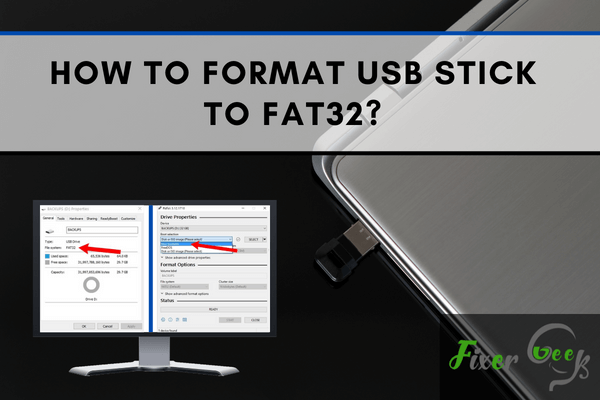How to Format USB Stick to FAT32? FAT32 is one of the oldest file systems in the world and is designed particularly for large devices like hard drives or flash drives. The most important point about this file system is that it supports all the feature of a small computer and even some other features, which many file systems don't possess. So you should learn the basic features of FAT32 and format a USB stick to FAT32 if you want your system to function properly.

The main reason for formatting a USB stick to FAT32 would usually be compatibility. FAT32 is known to be the most compatible format that can be read by most modern computers, gaming consoles, Android phones, and devices that use USB sticks, like portable speakers and such. The only downside to using FAT32 is its limited storage capacity since it only stores files with sizes no bigger than 4 gigabytes.
In this article, we will look at the various methods for formatting USB stick to FAT32.
Method 1: Standard Way
It is quite easy to format a USB stick to FAT32. Here’s how you can do it:
- Open My Computer or This PC.
- Right-click on the USB device you want to format.
- Click on Format.
- The default File system is usually FAT32. However, if it is not, be sure to change it to FAT32.
- You can enter any name you want for the Volume label.

- Make sure Quick Format is checked.
- Press Start and wait for the format to finish. The process usually takes a few seconds and you are good to go once it says that Format Complete.
Method 2: Using Software to Format a USB Stick
It is not easy to format USB drives with a capacity greater than 32GB. You will need to either use software to do the formatting for you or you will need to do extra steps that require tech expertise. Using the software is mostly recommended for people who don’t have any experience using PowerShell or Command Prompt.
So far, the best tool for your formatting needs would be Rufus. Not only is this software small in size but it is also portable. Therefore, you can bring it anywhere with you and use it anywhere and anytime. The steps below will guide you on how you can use Rufus to format your USB stick to FAT32.
- First and foremost, download Rufus.
- Open Rufus using the .exe file.
- Go to Boot selection and select Non bootable from the drop-down menu.

- On the drop-down box for the File system, select FAT32.
- You are free to change the Volume label to any name you want.
- Double-check everything before hitting Start. If all is well, you may proceed.
It will take a few seconds for the formatting process to finish. Once it is done, your USB stick should be usable by then.
Method 3: Using PowerShell
This process might be a little difficult if you are not familiar with PowerShell. For this reason, it is advisable to avoid this process if you are not sure about using PowerShell as this might turn your USB stick unusable.
- Plug in the device you want to format.
- Open Windows PowerShell (Admin).
- In the PowerShell window, type in the following command lines:
* format /FS:FAT32 (letter of the drive you want to format):
* Let’s say you want to format drive F, this is how the command line should look:
* format /FS:FAT32 F: - Hit Enter on your keyboard, wait for it to finish and that should be it.
Summary: Format USB Stick to FAT32
- Open the Run dialog box.
- Enter “management” into search box.
- Choose Disk Management.
- Select your USB drive from the list on the left.
- Select Format.
- Set desired label for the drive and pick exFAT file system if asked to choose between exFAT and NTFS.
- When you are done, hit OK button.
Conclusion
Whether you choose to format through the standard way or using third-party software, you should always make sure that all files saved on your USB stick are properly backed up. This is important since formatting will automatically remove all files stored in your drive. Also, always make sure to wait for the formatting process to finish before unplugging your USB stick. Otherwise, you risk corrupting your USB device and turn it into an expensive paperweight.